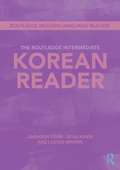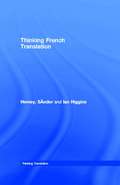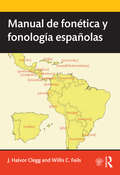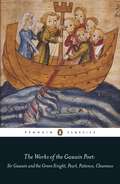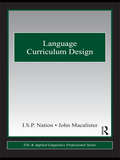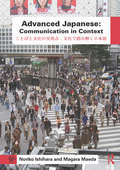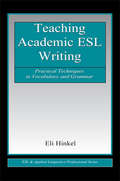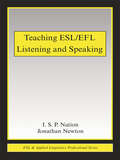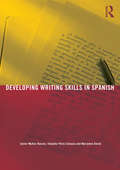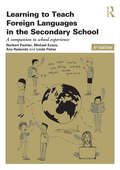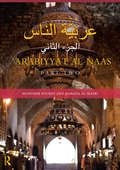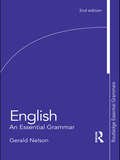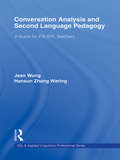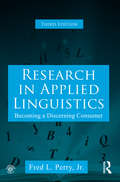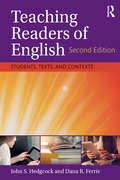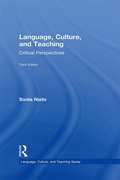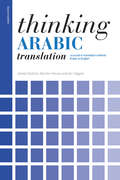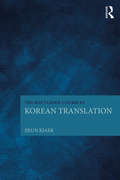- Table View
- List View
The Routlege Intermediate Korean Reader
by Jaehoon Yeon Jieun Kiaer Lucien BrownThe Routledge Intermediate Korean Reader is a comprehensive reader designed to provide varied, stimulating and up-to-date reading material for learners of Korean at the intermediate level. The Korean Reader provides a bridge between basic literacy skills and the ability to read full novels and newspapers in Korean. It consists of eighteen readings, graded on the basis of complexity of vocabulary, grammar and syntax. These readings present a range of different text types representative of modern Korean literary and popular writing which will inspire learners to continue reading independently in Korean. It is ideal for learners who already possess knowledge of essential grammar and vocabulary and who wish to expand their knowledge of the language through contextualized reading material. Key features include: extracts of modern literature and newspaper/magazine articles vocabulary lists for quick reference short grammar explanations of any complicated structures comprehension and discussion questions full answer key at the back. Suitable for both class use and independent study, The Routledge Intermediate Korean Reader is an essential tool for facilitating vocabulary learning and increasing reading proficiency. The Reader is ideal for learners at the intermediate-mid or intermediate high who are aiming to achieve advanced proficiency according to the ACTFL proficiency guidelines. In terms of the Common European Framework this equates to a progression from A2 through to B1/B2.
The Routlege Intermediate Korean Reader
by Jaehoon Yeon Jieun Kiaer Lucien BrownThe Routledge Intermediate Korean Reader is a comprehensive reader designed to provide varied, stimulating and up-to-date reading material for learners of Korean at the intermediate level. The Korean Reader provides a bridge between basic literacy skills and the ability to read full novels and newspapers in Korean. It consists of eighteen readings, graded on the basis of complexity of vocabulary, grammar and syntax. These readings present a range of different text types representative of modern Korean literary and popular writing which will inspire learners to continue reading independently in Korean. It is ideal for learners who already possess knowledge of essential grammar and vocabulary and who wish to expand their knowledge of the language through contextualized reading material. Key features include: extracts of modern literature and newspaper/magazine articles vocabulary lists for quick reference short grammar explanations of any complicated structures comprehension and discussion questions full answer key at the back. Suitable for both class use and independent study, The Routledge Intermediate Korean Reader is an essential tool for facilitating vocabulary learning and increasing reading proficiency. The Reader is ideal for learners at the intermediate-mid or intermediate high who are aiming to achieve advanced proficiency according to the ACTFL proficiency guidelines. In terms of the Common European Framework this equates to a progression from A2 through to B1/B2.
Thinking French Translation: A Course In Translation Method-french To English (Thinking Translation)
by Sándor Hervey Ian HigginsThe new edition of this popular course in translation from French into English offers a challenging practical approach to the acquisition of translation skills, with clear explanations of the theoretical issues involved. A variety of translation issues are considered including:*cultural differences*register and dialect*genre*revision and editing.The course now covers texts from a wide range of sources, including:*journalism and literature*commercial, legal and technical texts*songs and recorded interviews.This is essential reading for advanced undergraduates and postgraduate students of French on translation courses. The book will also appeal to wide range of language students and tutors.
Thinking French Translation (Thinking Translation)
by Sándor Hervey Ian HigginsThe new edition of this popular course in translation from French into English offers a challenging practical approach to the acquisition of translation skills, with clear explanations of the theoretical issues involved. A variety of translation issues are considered including:*cultural differences*register and dialect*genre*revision and editing.The course now covers texts from a wide range of sources, including:*journalism and literature*commercial, legal and technical texts*songs and recorded interviews.This is essential reading for advanced undergraduates and postgraduate students of French on translation courses. The book will also appeal to wide range of language students and tutors.
Manual de fonética y fonología españolas
by J. Halvor Clegg Willis C. FailsWritten entirely in Spanish, Manual de fonética y fonología españolas has a comprehensive scope that touches on all aspects of phonetics and phonology—including acoustic and auditory phonetics, phonotactics, and suprasegmentals, which most often remain untreated. The book provides students with a detailed and accurate yet accessible introduction to Spanish phonetics and phonology. It includes introductory chapters which place these disciplines within the general field of linguistics and which emphasize the role of sounds and their representation in human communication. Key features: Written by trained phoneticians and informed by the current science of phonetics. No prior knowledge of linguistics assumed, as a foundation is laid throughout for all linguistic terms and concepts. Each chapter contains a summary, a list of concepts and terminology, review questions, and pedagogically relevant pronunciation exercises keyed to the specific hints and suggestions provided in the chapters. Chapters dealing with the physical production of sounds contain sections with “Pedagogical Hints,” “Practical Suggestions,” and “Pronunciation Exercises” to link theory to the practical aspects of improving pronunciation. A wealth of graphic material to illustrate each concept clearly. Models of how to pronounce the sounds, sentences and exercises presented in the text, are available online at routledge.com/cw/clegg. Manual de fonética y fonología españolas is a comprehensive introduction designed to be clear and accessible to advanced students of Spanish to help them understand how to improve their pronunciation. It will serve as an excellent book for graduate students as well as a valuable resource for teachers, linguists and language professionals.
The Works of the Gawain Poet: Sir Gawain and the Green Knight, Pearl, Cleanness, Patience
by Ad Putter Myra StokesA new volume of the works of the Gawain poet, destined to become the definitive edition for students and scholars.This volume brings together four works of the unknown fourteenth-century poet famous for the Arthurian romance Sir Gawain and the Green Knight, in their original Middle English. In one of the great tales of medieval literature, Gawain, the noblest knight of King Arthur's court, must keep a deadly bargain with a monstrous knight and resist the advances of his host's beautiful wife. The dream vision of Pearl depicts a bereaved father whose lost child leads him to glimpse heaven. And in moral poems based on stories from the Bible, Cleanness warns against sins of the flesh and of desecration, while Patience encourages readers to endure suffering as God's will.Little is known about the so-called 'Gawain poet', who wrote during the late fourteenth century. It is believed that he came from south-east Cheshire, an important cultural and economic centre at the time, and he was clearly well-read in Latin, French and English. Although he is not named as the author of Sir Gawain and the Green Knight, Pearl, Patience, Cleanness, the four works have been attributed to him based on a careful comparison of their language, date and themes.Myra Stokes was formerly Senior Lecturer in the Department of English at Bristol University. Her books include Justice and Mercy in Piers Plowman and The Language of Jane Austen.Ad Putter teaches at the English Department and the Centre for Medieval Studies of the University of Bristol, where is Professor of Medieval English Literature. His monographs include Sir Gawain and the Green Knight and French Arthurian Romance and An Introduction to the Gawain Poet, and he is also co-editor of The Cambridge Companion to the Arthurian Legend.
Language Curriculum Design (ESL & Applied Linguistics Professional Series)
by I.S.P. Nation John MacalisterCrystal-clear and comprehensive yet concise, this text describes the steps involved in the curriculum design process, elaborates and justifies these steps, and provides opportunities for practicing and applying them. The description of the steps is done at a general level so that they can be applied in a wide range of particular circumstances. The process comes to life through plentiful examples of actual applications of the steps. Each chapter includes: examples from the authors’ experience and from published research tasks that encourage readers to relate the steps to their own experience case studies and suggestions for further reading that put readers in touch with others’ experience Curriculum, or course, design is largely a 'how-to-do-it' activity that involves the integration of knowledge from many of the areas in the field of Applied Linguistics, such as language acquisition research, teaching methodology, assessment, language description, and materials production. Combining sound research/theory with state-of-the-art practice, Language Curriculum Design is widely applicable for ESL/EFL language education courses around the world.
Advanced Japanese: Communication in Context
by Noriko Ishihara Magara MaedaThis innovative advanced level course in Japanese teaches appropriate language use in real life situations. With an emphasis on listening and speaking skills, the course takes a descriptive approach, demonstrating the variations that exist among Japanese speakers. Authentic sample dialogues demonstrate a range of generally preferred language uses, giving the student the tools to communicate in an effective and culturally appropriate manner. Organized according to frequently used functions of speech, such as requesting, apologizing, refusing and thanking and complimenting, Advanced Japanese presents commonly-used expressions and typical speech routines, providing the learner with the opportunity to familiarize themselves with their usage within the social context. Advanced Japanese: Communication in Context not only introduces commonly-used formulaic expressions, but also teaches learners how Japanese speakers assess crucial contextual factors such as relative social status, level of familiarity, and content of speech as they interpret a message and use language to convey their intentions. Key features of the textbook include: exercises throughout, including ‘core’ and ‘optional’ activities self-assessment section in each chapter unit summaries, grammar notes and role-play activities a separate Teacher’s Guide which fully supports the textbook featuring extensive notes and guidance also available through the companion website. Key features of the companion website include: complete audio files to accompany all dialogues within the textbook optional extra activities for students wishing to progress beyond the textbook teacher's guide – downloadable in both Japanese and English. Advanced Japanese: Communication in Context is the ideal resource for all intermediate to advanced learners of Japanese. The course is also an invaluable tool for anyone involved in the teaching of Japanese language. Noriko Ishihara is Associate Professor of EFL/TESOL at Hosei University, Japan. Magara Maeda teaches Japanese at the University of Wisconsin-River Falls, USA.
Teaching Academic ESL Writing: Practical Techniques in Vocabulary and Grammar (ESL & Applied Linguistics Professional Series)
by Eli HinkelTeaching Academic ESL Writing: Practical Techniques in Vocabulary and Grammar fills an important gap in teacher professional preparation by focusing on the grammatical and lexical features that are essential for all ESL writing teachers and student-writers to know. The fundamental assumption is that before students of English for academic purposes can begin to successfully produce academic writing, they must have the foundations of language in place--the language tools (grammar and vocabulary) they need to build a text. This text offers a compendium of techniques for teaching writing, grammar, and lexis to second-language learners that will help teachers effectively target specific problem areas of students' writing. Based on the findings of current research, including a large-scale study of close to 1,500 non-native speakers' essays, this book works with several sets of simple rules that collectively can make a noticeable and important difference in the quality of ESL students' writing. The teaching strategies and techniques are based on a highly practical principle for efficiently and successfully maximizing learners' language gains. Part I provides the background for the text and a sample of course curriculum guidelines to meet the learning needs of second-language teachers of writing and second-language writers. Parts II and III include the key elements of classroom teaching: what to teach and why, possible ways to teach the material in the classroom, common errors found in student prose and ways to teach students to avoid them, teaching activities and suggestions, and questions for discussion in a teacher-training course. Appendices to chapters provide supplementary word and phrase lists, collocations, sentence chunks, and diagrams that teachers can use as needed. The book is designed as a text for courses that prepare teachers to work with post-secondary EAP students and as a professional resource for teachers of students in EAP courses.
Teaching Academic ESL Writing: Practical Techniques in Vocabulary and Grammar (ESL & Applied Linguistics Professional Series)
by Eli HinkelTeaching Academic ESL Writing: Practical Techniques in Vocabulary and Grammar fills an important gap in teacher professional preparation by focusing on the grammatical and lexical features that are essential for all ESL writing teachers and student-writers to know. The fundamental assumption is that before students of English for academic purposes can begin to successfully produce academic writing, they must have the foundations of language in place--the language tools (grammar and vocabulary) they need to build a text. This text offers a compendium of techniques for teaching writing, grammar, and lexis to second-language learners that will help teachers effectively target specific problem areas of students' writing. Based on the findings of current research, including a large-scale study of close to 1,500 non-native speakers' essays, this book works with several sets of simple rules that collectively can make a noticeable and important difference in the quality of ESL students' writing. The teaching strategies and techniques are based on a highly practical principle for efficiently and successfully maximizing learners' language gains. Part I provides the background for the text and a sample of course curriculum guidelines to meet the learning needs of second-language teachers of writing and second-language writers. Parts II and III include the key elements of classroom teaching: what to teach and why, possible ways to teach the material in the classroom, common errors found in student prose and ways to teach students to avoid them, teaching activities and suggestions, and questions for discussion in a teacher-training course. Appendices to chapters provide supplementary word and phrase lists, collocations, sentence chunks, and diagrams that teachers can use as needed. The book is designed as a text for courses that prepare teachers to work with post-secondary EAP students and as a professional resource for teachers of students in EAP courses.
Teaching ESL/EFL Listening and Speaking (ESL & Applied Linguistics Professional Series)
by I.S.P. Nation Jonathan NewtonUsing a framework based on principles of teaching and learning, this guide for teachers and teacher trainees provides a wealth of suggestions for helping learners at all levels of proficiency develop their listening and speaking skills and fluency. By following these suggestions, which are organized around four strands – meaning-focused input, meaning-focused output, language-focused learning, and fluency development – teachers will be able to design and present a balanced program for their students. Teaching ESL/EFL Listening and Speaking, and its companion text, Teaching ESL/EFL Reading and Writing, are similar in format and the kinds of topics covered, but do not need to be used together. Drawing on research and theory in applied linguistics, their focus is strongly hands-on, featuring easily applied principles, a large number of useful teaching techniques, and guidelines for testing and monitoring. All Certificate, Diploma, Masters and Doctoral courses for teachers of English as a second or foreign language include a teaching methods component. The texts are designed for and have been field tested in such programs.
Teaching ESL/EFL Listening and Speaking (ESL & Applied Linguistics Professional Series)
by I.S.P. Nation Jonathan NewtonUsing a framework based on principles of teaching and learning, this guide for teachers and teacher trainees provides a wealth of suggestions for helping learners at all levels of proficiency develop their listening and speaking skills and fluency. By following these suggestions, which are organized around four strands – meaning-focused input, meaning-focused output, language-focused learning, and fluency development – teachers will be able to design and present a balanced program for their students. Teaching ESL/EFL Listening and Speaking, and its companion text, Teaching ESL/EFL Reading and Writing, are similar in format and the kinds of topics covered, but do not need to be used together. Drawing on research and theory in applied linguistics, their focus is strongly hands-on, featuring easily applied principles, a large number of useful teaching techniques, and guidelines for testing and monitoring. All Certificate, Diploma, Masters and Doctoral courses for teachers of English as a second or foreign language include a teaching methods component. The texts are designed for and have been field tested in such programs.
Developing Writing Skills in Spanish (Developing Writing Skills Ser.)
by Javier Muñoz-Basols Yolanda Pérez Sinusía Marianne DavidDeveloping Writing Skills in Spanish provides intermediate and advanced level students with the necessary skills to become competent and confident writers in the Spanish language. With a focus on writing as a craft, Developing Writing Skills in Spanish offers a rich selection of original materials including narrative texts, expository essays, opinion pieces and newspaper articles. Each chapter covers a specific kind of writing and is designed to help tackle the material in small units. The book aids students in crafting clear, coherent and cohesive manuscripts by means of guided practice and step-by-step activities. Key features: Guidance on how to structure a variety of texts: narrative, descriptive, expository, argumentative, academic, journalistic, legal and scientific. Sequenced exercises on style, writing conventions, word choice, syntax and grammar. Reference lists and tables with specialized vocabulary, transition words and other useful expressions. Strategies and tips for planning manuscripts, brainstorming ideas, vocabulary enrichment, editing and proofreading. Includes original samples, as well as fragments from newspapers, well-known literary works and essays by notable Hispanic authors and journalists. Website with additional activities to reinforce the content of each chapter and a teacher's guide with valuable support materials at: www.developingwritingskills.com Designed as a classroom text, self-study material or simply as a resource on writing, Developing Writing Skills in Spanish is the ideal supplement for all intermediate to advanced students of Spanish.
Developing Writing Skills in Spanish
by Javier Muñoz-Basols Yolanda Pérez Sinusía Marianne DavidDeveloping Writing Skills in Spanish provides intermediate and advanced level students with the necessary skills to become competent and confident writers in the Spanish language. With a focus on writing as a craft, Developing Writing Skills in Spanish offers a rich selection of original materials including narrative texts, expository essays, opinion pieces and newspaper articles. Each chapter covers a specific kind of writing and is designed to help tackle the material in small units. The book aids students in crafting clear, coherent and cohesive manuscripts by means of guided practice and step-by-step activities. Key features: Guidance on how to structure a variety of texts: narrative, descriptive, expository, argumentative, academic, journalistic, legal and scientific. Sequenced exercises on style, writing conventions, word choice, syntax and grammar. Reference lists and tables with specialized vocabulary, transition words and other useful expressions. Strategies and tips for planning manuscripts, brainstorming ideas, vocabulary enrichment, editing and proofreading. Includes original samples, as well as fragments from newspapers, well-known literary works and essays by notable Hispanic authors and journalists. Website with additional activities to reinforce the content of each chapter and a teacher's guide with valuable support materials at: www.developingwritingskills.com Designed as a classroom text, self-study material or simply as a resource on writing, Developing Writing Skills in Spanish is the ideal supplement for all intermediate to advanced students of Spanish.
Learning to Teach Foreign Languages in the Secondary School: A companion to school experience (Learning to Teach Subjects in the Secondary School Series)
by Norbert Pachler Michael Evans Ana Redondo Linda FisherPraise for previous editions:- ‘A wealth of theory, research, practical advice, case studies and tasks in one volume…Indispensable for both HEI tutors and mentors, and an important book to recommend to all MFL students.' – Language Learning Journal ‘Presenting clear, straightforward, factual information on all current issues facing MFL student teachers ... An excellent reference guide during the first years of teaching.' – Mentoring and Tutoring Learning to Teach Foreign Languages in the Secondary School has established itself as the leading textbook for student teachers of foreign languages in the UK and internationally. The practical focus is underpinned by a theoretical perspective and backed up by the latest research, encouraging you to develop a personal approach to foreign language teaching. This new, fourth edition, has been comprehensively updated to take account of recent policy and curriculum changes, and now covers a range of relevant statutory frameworks. Fully revised chapters cover the key knowledge and skills essential for becoming a foreign language teacher: What can we learn from research into language teaching and learning? Teaching methods and learning strategies Creating a meaningful learning environment Transition from Primary to Secondary The role of digital technologies Teaching in the target language Receptive skills and productive skills Teaching and learning grammar Planning and reflecting on classroom practice Pupil differences and differentiation Assessment for and of learning It includes many examples of how to analyse practice to ensure pupil learning is maximised, together with activities and tasks to support you as you analyse your own learning and performance. Learning to Teach Foreign Languages in the Secondary School provides practical help and support for many of the situations and potential challenges you are faced with in school. It is an essential purchase for every aspiring secondary foreign languages school teacher.
Arabiyyat al-Naas (Part Two): An Intermediate Course in Arabic (PDF)
by Munther Younes Hanada Al-MasriArabiyyat al Naas (Part Two): An Intermediate Course in Arabic offers a vibrant course in Arabic as it is written and spoken today by educated native speakers. Not only does it continue the innovative integration of Modern Standard Arabic (MSA) and Levantine Arabic used in Part One of the series, but it does so in a way that supports and develops students’ increased mastery of the language. Combining a greater focus on cultural topics with an increased coverage of MSA, Part Two introduces more sophisticated communication, giving students a deeper awareness of the cultural base of the Arabic language. Features include: Twenty-one theme-based units covering a wide range of relevant and engaging topics, including education and learning, jobs and professions, the Arab woman, religion, money and the economy, politics and government and the environment Thorough coverage of listening, speaking, writing and reading skills in every unit, with lessons structured to provide students with variety, stimulation and further opportunities for practice Humorous, realistic dialogues reflecting everyday educated speech among Arabs to build up strong and practical communication skills A rich variety of reading passages, including poems, short stories, newspaper articles, descriptions of Arab cities and biographies of famous figures, designed to improve comprehension and analytical skills and to deepen students’ knowledge of Arab history, culture, language, and literature An extensive range of appealing exercises and activities, including crossword puzzles, root-and-pattern identification exercises, passage completions, guided and free compositions, and songs Free accompanying CD that includes audio recordings of the listening materials in the 21 units and a number of songs tied to their themes Free companion website (www.routledge.com/cw/younes) featuring the texts of the listening passages, the audio recordings available on the CD , a track list of all the audio materials, the answer keys to the crossword puzzles, sample tests and language games. Developed by an experienced and dynamic author team and tested over a number of years at Cornell University, Arabiyyat al Naas (Part Two) will be an essential resource for intermediate-level students of Arabic. While primarily designed for classroom use, the accessibility of the course also renders it highly suitable for independent study. This volume is the second in a pioneering three-part series of Arabic textbooks which together provide a complete three-year undergraduate language program.
English: An Essential Grammar (Routledge Essential Grammars)
by Gerald NelsonEnglish: An Essential Grammar is a concise and user-friendly guide to the grammar of modern English, written specifically for native speakers and based on genuine samples of contemporary spoken and written English. In the first four chapters, this book covers the essentials of English grammar, beginning with the basics and going on to deal with phrase, clause and sentence structure. A fifth chapter deals with English word formation and spelling, including problem spellings and British and American spelling variants. Features include: discussion of points that often cause problems guidance on sentence building and composition practical spelling guidelines explanation of grammatical terms a set of exercises at the end of each chapter appendix of irregular verbs. With numerous language examples bringing grammar to life, this Essential Grammar will help you read, speak and write English with greater confidence. It is ideal for everyone who would like to improve their knowledge of English grammar. Gerald Nelson is Professor in the English Department at The Chinese University of Hong Kong, and formerly Reader in the Department of English Language and Literature, University College London, UK.
English: An Essential Grammar (Routledge Essential Grammars)
by Gerald NelsonEnglish: An Essential Grammar is a concise and user-friendly guide to the grammar of modern English, written specifically for native speakers and based on genuine samples of contemporary spoken and written English. In the first four chapters, this book covers the essentials of English grammar, beginning with the basics and going on to deal with phrase, clause and sentence structure. A fifth chapter deals with English word formation and spelling, including problem spellings and British and American spelling variants. Features include: discussion of points that often cause problems guidance on sentence building and composition practical spelling guidelines explanation of grammatical terms a set of exercises at the end of each chapter appendix of irregular verbs. With numerous language examples bringing grammar to life, this Essential Grammar will help you read, speak and write English with greater confidence. It is ideal for everyone who would like to improve their knowledge of English grammar. Gerald Nelson is Professor in the English Department at The Chinese University of Hong Kong, and formerly Reader in the Department of English Language and Literature, University College London, UK.
Conversation Analysis and Second Language Pedagogy: A Guide for ESL/ EFL Teachers (ESL & Applied Linguistics Professional Series)
by Jean Wong Hansun Zhang WaringConversation and speaking skills are the key building blocks for much of language learning. This text increases teachers’ awareness about spoken language and suggests ways of applying that knowledge to teaching second-language interaction skills based on insights from Conversation Analysis (CA). Conversation Analysis and Second Language Pedagogy: reviews key CA concepts and findings directly connects findings from CA with second language pedagogy presents a model of interactional practices grounded in CA concepts includes numerous transcripts of actual talk invites readers to complete a variety of tasks to solidify and extend their understandings features a useful collection of practical teaching activities. The time is ripe for a book that blends conversation analysis and applied linguistics. This text takes that important step, extending the reaches of these once separate academic fields. Assuming neither background knowledge of conversation analysis nor its connection to second language teaching, it is designed for courses in TESOL and applied linguistics and as a resource for experienced teachers, material developers, and language assessment specialists seeking to update their knowledge and hone their craft.
Conversation Analysis and Second Language Pedagogy: A Guide for ESL/ EFL Teachers (ESL & Applied Linguistics Professional Series)
by Jean Wong Hansun Zhang WaringConversation and speaking skills are the key building blocks for much of language learning. This text increases teachers’ awareness about spoken language and suggests ways of applying that knowledge to teaching second-language interaction skills based on insights from Conversation Analysis (CA). Conversation Analysis and Second Language Pedagogy: reviews key CA concepts and findings directly connects findings from CA with second language pedagogy presents a model of interactional practices grounded in CA concepts includes numerous transcripts of actual talk invites readers to complete a variety of tasks to solidify and extend their understandings features a useful collection of practical teaching activities. The time is ripe for a book that blends conversation analysis and applied linguistics. This text takes that important step, extending the reaches of these once separate academic fields. Assuming neither background knowledge of conversation analysis nor its connection to second language teaching, it is designed for courses in TESOL and applied linguistics and as a resource for experienced teachers, material developers, and language assessment specialists seeking to update their knowledge and hone their craft.
Research in Applied Linguistics: Becoming a Discerning Consumer
by Fred L. Perry, Jr.Now in its third edition, this popular introduction to the foundations of research methods is designed to enable students and professionals in the field of applied linguistics to become not just casual consumers of research who passively read bits and pieces of a research article, but discerning consumers able to effectively use published research for practical purposes in educational settings. All issues important for understanding and using published research for these purposes are covered. Key principles are illustrated with research studies published in refereed journals across a wide spectrum of applied linguistics. Exercises throughout the text encourage readers to engage interactively with what they are reading at the point when the information is fresh in their minds. Intended for and field-tested in courses in MA-TESOL/TEFL and applied linguistics programs, course instructors will find that this text provides a solid framework in which to promote student interaction and discussion on important issues in research methodology. This book provides an excellent foundation for those who plan to continue in an active research agenda. Changes in the Third Edition Chapter 2 revised to reflect formatting changes made by ERIC, addition of referencing and citation resources Chapter 8 revised to increase practicality Revision of some embedded exercises The topic of meta-analysis integrated more fully where appropriate Corpora research given more attention Many studies older than 2000 replaced with more recent studies Companion Website (www.routledge.com/cw/Perry) with list of journals related to applied linguistics, annotated resources to aid students and instructors for each chapter, access to screencasts and YouTube demonstrations, and a space for students and/or teachers to interact with the author.
Teaching Readers of English: Students, Texts, and Contexts
by John S. Hedgcock Dana R. FerrisA comprehensive manual for pre- and in-service ESL, EFL, and EIL educators who work with multilingual students at the secondary and postsecondary levels, this text balances insights from reading theory and research with highly practical, field-tested strategies for teaching and assessing second-language reading that educators can readily adopt and adapt to suit their contexts and student populations. Teaching Readers of English is a complete "go-to" source for teaching reading and promoting classroom and professional literacies in an increasingly digital world. Offering principled approaches and methods for planning and delivering effective L2 reading instruction, the text includes pedagogical features, such as questions for reflection, further reading and resources, and application activities to develop purposeful classroom reading lessons in a range of contexts. Changes in the Second Edition: Updated and revised chapters on formative and summative reading assessment, developing vocabulary knowledge and grammatical skill, and cultivating extensive reading and literary appreciation Updated information on institutional settings and reader demographics New pedagogical features in each chapter, including Chapter Summaries, Further Reading, Reflection and Review, and Application Activities A streamlined chapter sequence to enhance the text’s usability
Language, Culture, and Teaching: Critical Perspectives (Language, Culture, and Teaching #23)
by Sonia NietoDistinguished multiculturalist Sonia Nieto speaks directly to current and future teachers in this thoughtful integration of a selection of her key writings with creative pedagogical features. Offering information, insights, and motivation to teach students of diverse cultural, racial, and linguistic backgrounds, examples are included throughout to illustrate real-life dilemmas about diversity that teachers face in their own classrooms; ideas about how language, culture, and teaching are linked; and ways to engage with these ideas through reflection and collaborative inquiry. Designed for upper-undergraduate and graduate-level students and professional development courses, each chapter includes critical questions, classroom activities, and community activities suggesting projects beyond the classroom context. Language, Culture, and Teaching • explores how language and culture are connected to teaching and learning in educational settings; • examines the sociocultural and sociopolitical contexts of language and culture to understand how these contexts may affect student learning and achievement; • analyzes the implications of linguistic and cultural diversity for classroom practices, school reform, and educational equity; • encourages practicing and preservice teachers to reflect critically on their classroom practices, as well as on larger institutional policies related to linguistic and cultural diversity based on the above understandings; and • motivates teachers to understand their ethical and political responsibilities to work, together with their students, colleagues, and families, for more socially just classrooms, schools, and society. Changes in the Third Edition: This edition includes new and updated chapters, section introductions, critical questions, classroom and community activities, and resources, bringing it up-to-date in terms of recent educational policy issues and demographic changes in the U.S. and beyond. The new chapters reflect Nieto’s current thinking about the profession and society, especially about changes in the teaching profession, both positive and negative, since the publication of the second edition of this text.
Thinking Arabic Translation: A Course in Translation Method: Arabic to English (Thinking Translation)
by James Dickins Sándor Hervey Ian HigginsThinking Arabic Translation is an indispensable book for linguists who want to develop their Arabic-to-English translation skills. Clear explanations, discussions, examples and exercises enable students to acquire the skills necessary for tackling a broad range of translation problems. The book has a practical orientation, addressing key issues for translators, such as cultural differences, genre, and revision and editing. It is a book on translation method, drawing on a range of notions from linguistics and translation theory to encourage thoughtful consideration of possible solutions to practical problems. This new edition includes: • new material in almost all chapters • a new chapter on parallelism • two new chapters on technical translation: botanical and Islamic finance texts • new and up-to-date examples from all types of translation, covering broad issues that have emerged in the Arab world in recent years • texts drawn from a wide variety of writing types, including newspapers, prose fiction, poetry, tourist material, scientific texts, financial texts, recipes, academic writing, constitutions and political speeches • at least three full-length practical translation exercises in each chapter to complement the discussions and consolidate learning. In addition to the updated Tutor’s Handbook, a Supplement, containing textual material and practical exercises aimed at further developing the translation issues discussed in the main text, and a Tutor’s Handbook to the Supplement, are available at www.routledge.com/cw/dickins. Thinking Arabic Translation is key reading for advanced students wishing to perfect their language skills or considering a career in translation.
The Routledge Course in Korean Translation
by Jieun KiaerThe Routledge Course in Korean Translation brings together for the first time materials dedicated to the theory and practice of translation to and from Korean. This advanced course in Korean translation discusses cross-linguistic and cross-cultural issues that arise in the course of Korean-English and English-Korean translation and offers useful tools for dealing with the problems that arise in the actual practice of translation. Equipped with examples from a range of genres, this book provides a foundational understanding in translation theory that is necessary in Korean translation. The Routledge Course in Korean Translation is essential reading for students of Korean at both undergraduate and postgraduate levels interested in translation, as well as for students and researchers with knowledge of Korean who are interested in linguistics, and cultural and comunication studies.
